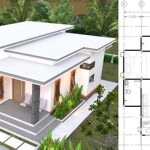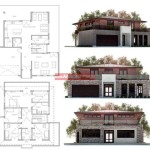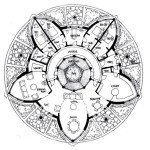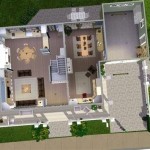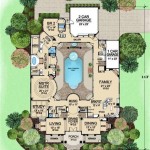Architecture Plan For 4 Bedroom House: Essential Aspects
Designing an architecture plan for a 4-bedroom house requires meticulous planning and attention to detail. Several key aspects must be considered to create a functional, comfortable, and aesthetically pleasing living space. This comprehensive guide will delve into the essential elements that should be incorporated into your architectural plan.
Zoning and Layout
The initial step involves dividing the house into different zones, including living areas, sleeping quarters, and utility spaces. The layout should ensure smooth transitions between rooms and promote efficient movement. Adequate space allocation for each room is crucial, considering the number of occupants and their lifestyle.
Natural Lighting
Natural lighting plays a vital role in creating a welcoming and healthy living environment. Incorporate large windows and skylights to maximize sunlight penetration. Consider the orientation of the house to harness natural light throughout the day. Proper window placement can reduce energy consumption for artificial lighting.
Ventilation and Airflow
Adequate ventilation is essential for maintaining a comfortable indoor climate. Cross-ventilation strategies, such as positioning windows on opposite walls, allow for efficient air circulation. Incorporate natural ventilation systems like chimneys or vents to remove stale air and promote fresh air intake.
Kitchen Design
The kitchen is often considered the heart of the home. Plan a functional and ergonomic kitchen layout, ensuring an efficient workflow. Consider the placement of appliances, cabinets, and countertops to minimize unnecessary steps. Adequate storage space and natural lighting are crucial for a well-designed kitchen.
Bathroom Planning
Bathrooms should be designed with both functionality and comfort in mind. Consider allocating separate areas for bathing, toileting, and vanity. Adequate ventilation and natural lighting are essential to prevent moisture buildup. Ensure proper plumbing fixtures and consider accessible design features for all users.
Structural Considerations
The structural integrity of the house is paramount. The architectural plan should consider the local building codes and geological conditions. Proper foundation design, load-bearing walls, and roofing systems are essential for the safety and durability of the structure.
Sustainability and Energy Efficiency
Incorporating sustainable practices into the architectural plan is crucial for reducing environmental impact and energy consumption. Consider using energy-efficient appliances, insulation materials, and renewable energy sources like solar panels. Implement water conservation measures and choose sustainable building materials to create an eco-friendly living space.
Exterior Design
The exterior design should complement the architecture and enhance the overall aesthetic appeal of the house. Consider the materials, colors, and textures used to create a cohesive and visually appealing facade. Landscaping, outdoor spaces, and pathways should integrate seamlessly with the architectural plan.
Conclusion
Creating an architecture plan for a 4-bedroom house involves a comprehensive approach that considers various essential aspects. By incorporating these principles into the design process, homeowners can achieve a functional, comfortable, and aesthetically pleasing living space. These guidelines ensure that the architectural plan aligns with the lifestyle, needs, and aspirations of the occupants, creating a home that fosters well-being and enriches daily life.

4 Bedroom House Plan Examples

4 Bedroom House Plans 2960 Sq Foot 272 M2 Sunken Lounge Study Nook Plan Bed On Today

4 Bedroom Home Design Plan 7 5x9m Samphoas Plansearch House Construction Model Beautiful Plans

4 Bedroom House Free Design 3d Floor Plans By Planner 5d
4 Bedroom House Plans Top 8 Floor Design Ideas For Four Bed Homes Architecture

Four Bedroom House Plans 4 Designs Floor The Designers

4 Bedroom House Autocad Ground Floor Plan Design Cadbull

4 Bedroom Apartment House Plans Futura Home Decorating Planos De Casas Modernas Pisos

Beautiful 4 Bedroom House Plan With Photos Floor Nethouseplans

4 Bedroom Modern House Plan Contemporary Plans Plandeluxe

